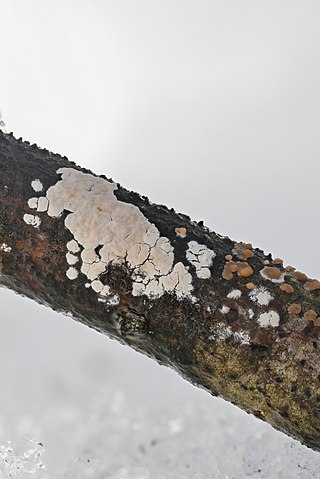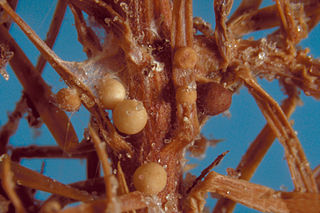
The pathogenic fungus Cryphonectria parasitica is a member of the Ascomycota. This necrotrophic fungus is native to East Asia and South East Asia and was introduced into Europe and North America in the early 1900s. The fungus spread rapidly and caused significant tree loss in both regions.
Blight refers to a specific symptom affecting plants in response to infection by a pathogenic organism.
Ceratobasidium ochroleucum is a species of fungus in the family Ceratobasidiaceae. Basidiocarps are effused and web-like and were originally described from Brazil, causing a thread blight of apple and quince trees. The fungus was subsequently reported as a leaf disease on orchard crops in North America, but since descriptions of Ceratobasidium orchroleucum vary considerably and no type specimen exists, its identity remains unclear. Roberts (1999) considered it a "nomen dubium".
Pestalotiopsis palmarum is the causative agent of a fungal disease of bananas, coconut and Date palms. The fungus causes leaf spots, petiole/rachis blights and sometimes bud rot of palms. Unlike other leaf spot and blight diseases, Pestalotiopsis palmarun attacks all parts of the leaf from the base to the tip. Whereas most diseases only infect the leaf blade or the leaf petiole.
Botryosphaeria cocogena is a fungus species in the family Botryosphaeriaceae. Originally discovered in the Brazilian Amazon rainforest, it is a plant pathogen that causes blight in coconut leaves.

Ceratobasidium cornigerum is a species of fungus in the order Cantharellales. Basidiocarps are thin, spread on the substrate out like a film (effused) and web-like. An anamorphic state is frequently obtained when isolates are cultured. Ceratobasidium cornigerum is saprotrophic, but is also a facultative plant pathogen, causing a number of economically important crop diseases, and an orchid endomycorrhizal associate. The species is genetically diverse and is sometimes treated as a complex of closely related taxa. DNA research shows the species actually belongs within the genus Rhizoctonia.
Corticium invisum is a species of fungus in the class Agaricomycetes. It is a corticioid fungus and a plant pathogen, the causal agent of black rot of tea, and was originally described from Sri Lanka. Corticium invisum has never been redescribed or reviewed and is unlikely to be a species of Corticium in the modern sense. Roberts (1999) referred Petch's original specimens to Ceratobasidium cornigerum.
Rhizochaete is a plant pathogen infecting planes, beeches, pines, oaks and other trees.
Granulobasidium vellereum is a species of fungus in the family Cyphellaceae. A plant pathogen associated with white rot of angiospermous logs, slash, and living trees, it has been found in Sweden and Denmark, and in North America. Originally described as Corticium vellereum in 1885, it was transferred to the genus Granulobasidium by Walter Jülich in 1979.

Corticium roseum is a species of fungus in the family Corticiaceae. Basidiocarps are effused, smooth, corticioid, and pink. The species has a wide, north and south temperate distribution and in Europe is typically found on dead, attached branches of Salix and Populus.

The Corticiaceae are a family of fungi in the order Corticiales. The family formerly included almost all the corticioid fungi, whether they were related or not, and as such was highly artificial. In its current sense, however, the name Corticiaceae is restricted to a comparatively small group of corticioid genera within the Corticiales.

Terana caerulea, commonly known as the cobalt crust fungus or velvet blue spread, is a saprobic crust fungus in the family Phanerochaetaceae. Usually found in warm, damp hardwood forests on the undersides of fallen logs and branches of deciduous trees, this unique fungus has been described as "blue velvet on a stick". This species was chosen as fungus of the year for 2009 by the German Mycological Society.
Alternaria penicillata is a species of fungi in the family Pleosporaceae, which causes leaf blight of opium poppy. The fungus is found in Europe, Australia, India, Japan, Nepal, Pakistan, South Africa, Turkey, USA and Zambia.
Hypovirus is a genus of viruses, in the family Hypoviridae. Fungi serve as natural hosts. There are four species in this genus. Infection reduces the virulence of its parasitic host, making it a hyperparasite useful for blight control.

The corticioid fungi are a group of fungi in the Basidiomycota typically having effused, smooth basidiocarps that are formed on the undersides of dead tree trunks or branches. They are sometimes colloquially called crust fungi or patch fungi. Originally such fungi were referred to the genus Corticium and subsequently to the family Corticiaceae, but it is now known that all corticioid species are not necessarily closely related. The fact that they look similar is an example of convergent evolution. Since they are often studied as a group, it is convenient to retain the informal (non-taxonomic) name of "corticioid fungi" and this term is frequently used in research papers and other texts.
Crustodontia is a fungal genus of uncertain familial placement in the order Polyporales. The genus was circumscribed in 2005 to contain the crust fungus Crustodontia chrysocreas. This species was originally described as Corticium chrysocreas by Miles Berkeley and Moses Ashley Curtis in 1873. Their description was as follows: "Subiculum bright yellow, thin; hymenium immarginate pallid, or yellow tinged with tawny." Crustodontia has a monomitic hyphal system, meaning it contains only generative hyphae, and these hyphae have clamp connections.
Cerocorticium molle is a species of crust fungus in the family Meruliaceae.

Botryobasidium is a genus of corticioid fungi belonging to the order Cantharellales. Basidiocarps are ephemeral and typically form thin, web-like, white to cream, effused patches on the underside of fallen branches, logs, and leaf litter. Several species form anamorphs producing chlamydospores. All species are wood- or litter-rotting saprotrophs and the genus has a worldwide distribution.

Agroathelia rolfsii is a corticioid fungus in the order Amylocorticiales. It is a facultative plant pathogen and is the causal agent of "southern blight" disease in crops.







